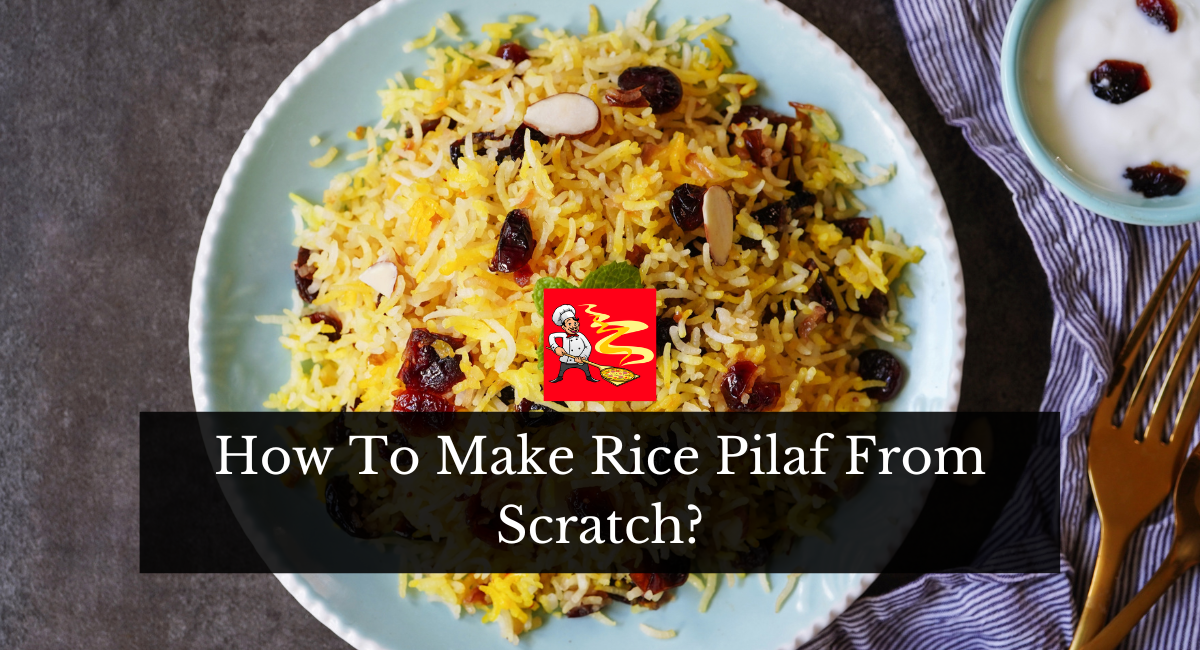Rice pilaf, a dish celebrated for its aromatic flavors and fluffy texture, has graced tables across various cultures for centuries. While countless pre-packaged versions are available, nothing quite compares to the depth of flavor achieved when made from scratch.
Crafting rice pilaf at home allows for a personal touch, ensuring each grain is perfectly seasoned and cooked.
This article guides you through the art of making rice pilaf from scratch, promising a culinary experience that’s both rewarding and delicious.
How To Make Rice Pilaf From Scratch?
Rice pilaf is a delightful dish where rice is cooked in a seasoned broth, often with the addition of sautéed onions and other vegetables or proteins. The grains remain separate, resulting in a fluffy & aromatic side dish that pairs great with a variety of main courses.
Time Required
- Prep Time: 10 minutes
- Cook Time: 25 minutes
- Total Time: 35 minutes
Ingredients
- 1 cup long-grain white rice
- 2 cups chicken or vegetable broth
- 1 medium onion, finely chopped
- 2 tablespoons unsalted butter or olive oil
- 1/4 cup diced carrots (optional)
- 1/4 cup diced bell peppers (optional)
- Salt and pepper to taste
- Fresh herbs such as parsley or cilantro for garnish
Instructions
- In a large saucepan, melt the butter or heat the olive oil over medium heat.
- Add the chopped onion and sauté until translucent, about 3-4 minutes.
- If using, add the diced carrots and bell peppers and sauté for another 2-3 minutes.
- Stir in the rice, ensuring each grain is coated with the butter or oil.
- Pour in the broth & season with salt and pepper.
- Bring the mixture to a boil, then lower down the heat to low, cover, & simmer for 20 minutes or until the rice is tender & the liquid is absorbed.
- Remove from heat & let it sit covered up for 5 minutes.
- Fluff the rice with a fork and then garnish with fresh herbs, and serve.
Tips
- Rinse the Rice: Before cooking, wash the rice under cold water to remove excess starch. This helps in getting non-sticky grains.
- Use Broth: For added flavor, use chicken or vegetable broth instead of water.
- Sauté the Grains: Sautéing the rice in butter or oil before adding the broth ensures each grain is coated, leading to fluffier rice.
- Keep the Lid On: While simmering, resist the urge to lift the lid. This keeps the steam in and cooks the rice evenly.
- Use a Fork: After cooking, fluff the rice with a fork instead of a spoon to prevent the grains from breaking.
- Variations: Feel free to add other vegetables like peas corn, or even proteins like chicken or shrimp.
- Herbs: Fresh herbs like parsley, cilantro, or dill can elevate the flavor of your pilaf.
Storage
- Allow the rice pilaf to cool completely before transferring it to an airtight container.
- Store in the refrigerator for up to 3-4 days.
- For longer storage, freeze in portion-sized containers or freezer bags for up to 2 months. Thaw in the refrigerator before reheating.
Serving Suggestions
- Serve rice pilaf as a side dish with grilled meats, stews, or curries.
- Top with roasted nuts or dried fruits for added texture and flavor.
- Pair with a fresh salad and yogurt sauce for a light meal.
- Use as a filling for stuffed vegetables or wraps.
What Is The Formula For Rice Pilaf?
The basic formula for making rice pilaf is as follows:
- Heat fat (such as butter or oil) in a pan.
- Sauté aromatics (like onions, garlic, or shallots) until translucent.
- Add rice and toast for a few minutes.
- Pour in broth or water, typically in a 2:1 ratio (2 parts liquid to 1 part rice).
- Season with salt and any desired herbs or spices.
- Simmer covered until the rice is cooked and the liquid is absorbed.
- Fluff with a fork before serving.
Is Pilaf And Pulao Same?
Pilaf and pulao are similar rice dishes but have some regional and culinary variations. Both involve cooking rice with aromatics and spices. The key difference lies in the method and ingredients. Pilaf is typically cooked by sautéing rice in fat before adding liquid, while pulao involves simmering rice with the liquid and ingredients together.
Additionally, the choice of spices and ingredients can vary by region. Overall, they share similarities but have distinct preparation techniques and flavors based on cultural influences.
Bottom Line
Making rice pilaf from scratch is a journey of understanding the delicate balance between rice, broth, and seasonings. By following this comprehensive guide, you’ll master the techniques to achieve that signature light and separate grain texture infused with the rich aromas of herbs and spices.
Whether served as a side dish or the main course, homemade rice pilaf is a testament to the beauty of simple ingredients coming together in harmony, offering a taste that’s authentically unmatched.
Also read: How To Cook Bone In Spiral Ham?

